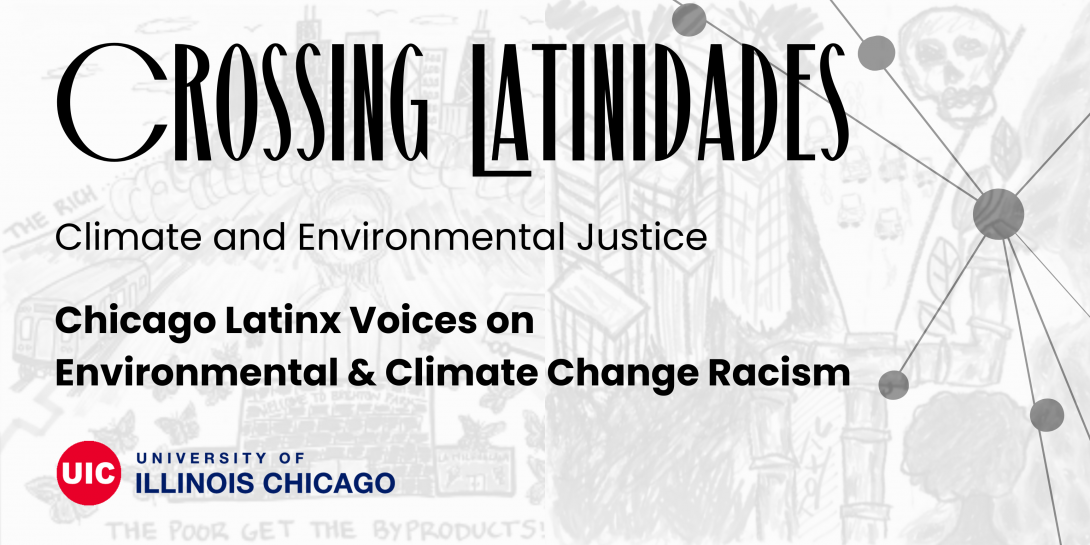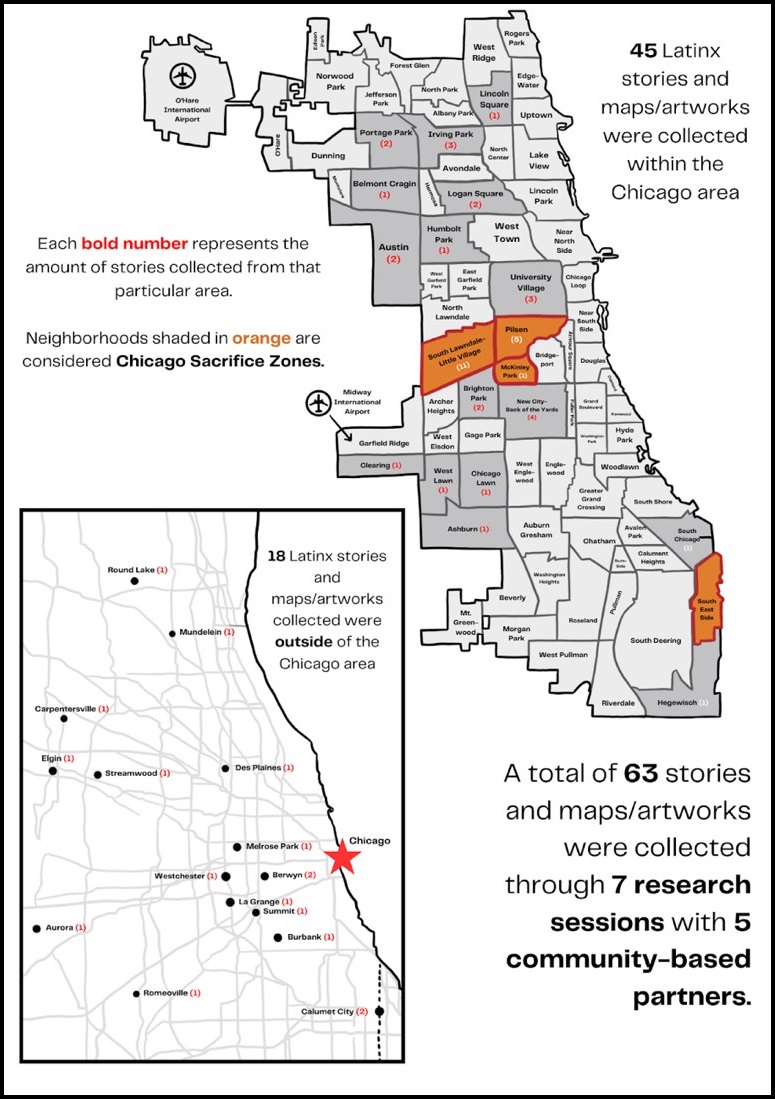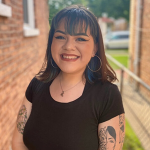
Summary
The Chicago Latinx Voices on Environmental & Climate Change Racism study aims to better understand how Latinx communities have endured, confronted and/or adapted to systematic environmental injustices including pollution and extreme climate events. We focused on the Chicago context and some of its surrounding areas. Our study has disclosed a series of residents’ concerns, attitudes, and assets that served to organize the findings into three main themes for deeper analysis:
-
-
Recognizing the critical intersection of environmental and social justice
-
Underscoring who the real polluters are and demanding accountability
-
Placekeeping and activating cultural assets
-
We used a mixed method approach including visual ethnography, participant observation, and a demographic survey to obtain data. There was a total of 7 research sessions, each took approximately 90 minutes for participants (storytellers hereafter) to complete a demographic survey and create their personal maps/artworks with written descriptive stories. Each research session was co-facilitated in English or Spanish by a researcher on the project team and a local community artist or facilitated by a researcher who had an art background when an artist was not available. We collected 63 sets of personal maps/artworks and written stories from Latinx storytellers. Out of 63 storytellers, 45 live in Chicago and 18 in suburban areas as indicated in Figure 1 (below): Maps with areas that generated stories and maps/artworks.

The research was collaborative and conducted with the UIC Rafael Cintrón Ortiz Latino Cultural Center (LCC) and community partners Alianza Americas, Centro San Bonifacio, Enlace Chicago, Little Village Environmental Justice Organization (LVEJO), and Neighbors for Environmental Justice. Their participation focused on recruiting storytellers and providing space for the research sessions. Below are some of the stories with corresponding artworks generated by Latinx storytellers.
Data and Analysis
This ArcGIS map is also available on full screen here.
To download this report, please click here.
Takeaways
Conceptions and framing of climate change
Storytellers generally framed climate change within environmental pollution since the issue of pollution has been at the forefront of the EJ movement focused on local impacts experiences while the climate change movement for a long time was understood in terms of global warming and the imperative to retire fossil fuels. One of the stories in this study declared that “climate change is an environmental justice issue” and this is a guiding statement that helps us see how people who have been historically exposed to environmental harms generally frame and recognize climate change. It is not coincidental that storytellers living in the city and particularly residing in sacrifice zones or near these areas recognized the association of residential racial segregation and concentration of environmental hazards in predominantly Black and Latinx neighborhoods.
Climate Change triggering further inequities in Latinx communities in Chicago
Mental Health: The issue of environmental related health hazards was raised as a top concern in our study. However, what surfaced as a significant companion was the harm on mental health that environmental issues including the climate crisis was causing on them. Considering that Latinxs are among the top groups being harmed disproportionately by climate change since they have higher rates of health risks and receive lower-quality health care (Colon-Rivera, H. and Plata G. 2021) coupled with the growing climate related displacement that is forcing people from Latin America countries to find refuge across the USA border, the inequities in Latinx communities are poised to worsen.
Community displacement: Concerns about current polluters expanding or new ones setting up shop in their neighborhoods and causing further disruptions in their lives raised to the top. In 2023 massive warehouses sprouted across the Chicago metro area as online orders increased since the pandemic and many retailers shifted to online-first. This aligns with a new study where medium to large size trucks driving through 17 Chicago neighborhoods were counted, showing a disproportionate number of trucks passing through Black and Latinx neighborhoods (LVEJO, CNT, 2023). These increasing pollutants and the unsettling feelings of future displacement that residents are experiencing are serious environmental stressors that are elevating inequities in Latinx communities in Chicago.
Community and household adaptation strategies
Placekeeping, Heritage-Based Assets, Advocacy, and Mutual Aid: Latinxs in Chicago are deploying a wide range of cultural assets to resist further environmental damage in their neighborhoods that include sustaining a sense of place/belonging (placekeeping); revitalizing environmentally friendly practices from their homeland, which was significant among immigrant storytellers; getting involved in local EJ advocacy; and embracing a holistic community wellness approach that take care of people and the environment. Harnessing hope, elevating pride, and nourishing determination to improve community life to sustain a sense of place is a major adaptation strategy that Latinxs are employing to disrupt the existing environmental dire conditions that affect their families, communities, and the place they call home.
People

Executive Director of the Rafael Cintrón Ortiz Latino Cultural Center at the University of Illinois Chicago

Civic Engagement Educator of the Rafael Cintrón Ortiz Latino Cultural Center at the University of Illinois Chicago
This project is supported by the Crossing Latinidades Humanities Research Initiative, which ignites cross-institutional and cross-regional comparative research, training of doctoral students, and new scholarship in emerging areas of inquiry about Latina/os. Funded by a grant from the Andrew W. Mellon Foundation, the initiative serves as the anchor of the Alliance of Hispanic Serving Research Universities, a consortium of R1 Hispanic Serving Institutions.
To go back to Crossing Latinidades: Climate and Environmental Justice landing page, please click here.